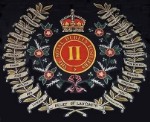Naas Barracks, County Kildare
Naas Barracks housed the depot of the Royal Dublin Fusiliers from 1873 to 1922. Upon Irish independence, the War Office handed the property to pro-treaty IRA forces of the Irish Free State.
All recruits for the regiment's two regular battalions received their basic training here. About 80% of the RDF militia recruits also received such training at Naas Barracks. The remaining 20% of militia recruits were trained by the militia battalion staffs during "Preliminary Drill." In 1904, the officer commanding the depot was Major Walter Bromilow. The barracks also housed the headquarters of the Kildare Militia (3rd Bat./Royal Dublin Fusiliers), commanded by Lieutenant-Colonel William Henry Slingsby O'Neill, a retired Regular Army officer. The depot permanent complement (5 officers, 26 NCOs, 40 privates, 2 drummers) provided the staff of the 102nd Regimental District which was responsible for the administration of all reservists that resided in the four county territory. In 1904, the officer commanding the district was Colonel Charles D. Cooper.
In peace-time, an infantry depot had four training companies, each for a maximum of eighty recruits. Basic training for regulars was 13 weeks; for militiamen 7 weeks. A depot could train 1,200 to 1,300 recruits per year.
n/ War Office, Infantry Training Manual (London: HMSO, 1900); MG A.E. Turner, Statement Showing the Average Time Devoted to Drill and Training by Recruits and Trained Men of the Militia, Norfolk Commission Report, Appendices, 1904, [Cd. 2064], no. 58; Monthly Army List, July 1904; Hart's Annual Army List, 1904; War Office, Army Estimates for the Year 1904-05, 1904, H.C. Accounts & Papers, No. 73.
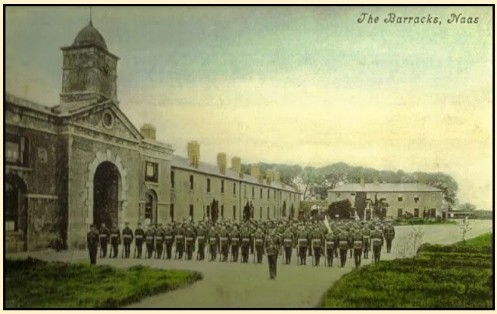
First World War Era Postcard
Naas Barracks opened in 1813 to house 18 officers and 300 enlisted men; twice those numbers during wartime. In the early nineteenth century, officers apparently found Naas an undesirable posting. In 1832, Captain William St. Leger Alcock wrote that Naas "was the stupidest place imaginable, no one but Lord Mayo living in the neighborhood." The captain; however, was satisfied with the accommodations which he described as excellent.
The new barracks was headquarters for the County Kildare Militia and a training depot for the regular army. In 1873, Naas Barracks became the depot for the 102nd and 103rd Regiments of Foot, then in India, and headquarters for the 66th Sub-District Brigade. The brigade supervised the Carlow, Kildare, Wicklow, Dublin City and Dublin County Militias.
In 1881, the War Office redesignated the 66th Sub-District as the 102nd Regimental District with Naas Barracks as depot for the newly created Royal Dublin Fusiliers. The barracks remained headquarters of the Kildare Militia, (3rd Battalion, Royal Dublin Fusiliers). The district staff managed reservists resident in the territory which encompassed Counties Dublin, Wicklow, Kildare, and Carlow. Uniforms and equipment for such reservists were stored at the barracks.
Rail service between Dublin and Naas began in 1884. On Bloomsday, Naas was best known for the Punchestown Racecourse located four kilometers to the southeast.
n/ Con Costello, "From Fusiliers to Army Apprentice School," Website of Irish Identity at www.irishidentity.com/extras/hidden/stories/barracks.htm. Hart's Annual Army List, 1874, 1882.
After creation of the Free State, the new Irish national army renamed the facility Devoy Barracks and at the end of the Civil War the 33rd Infantry Battalion was based there. That unit was disbanded in the post-war demobilization and the 13th Infantry Battalion moved into Devoy Barracks. The 13th was quartered there until it was disbanded in 1928. With the substantial reduction-in-force of the National Army, the Irish government transferred most of the barracks property to the Office of Public Works. In 1934, the new married soldiers' quarters (built on the site of the old enlisted men's huts) were transferred to the Naas Town Council and renamed St. Patrick's Terrace.
The last army establishment to occupy Devoy Barracks was the Army Apprentice School, created in 1956. In 1998, the government closed what remained of Devoy Barracks. The area on which Naas Barracks was situated is now mostly an industrial park. The housing estate occupies what was once the northwestern corner of the barracks.
All that remains of the original structures of Naas Barracks is the main entrance to the enlisted men's quarters with its clocktower (visible in the postcard above).
n/ Paul V. Walsh, "The Irish Civil War, 1922-1923;" Adrian J. English, Irish Army Orders of Battle 1923-2004 (Takoma Park, MD: Tiger Lily, 2004); Naas Local History Group, "Devoy Barracks - Arch and Clock Tower".
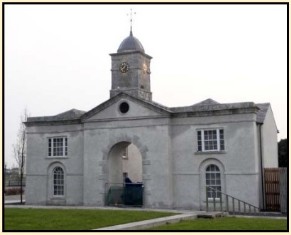
The Town of Naas is in County Kildare about 30 kilometers southwest of Dublin City Center. In 1904, it would take somewhat over an hour to travel from Naas to Dublin on the Great Southern and Western Railway. One would arrive in Dublin at Kingsbridge Terminus (now named Heuston Station), in Kilmainham.
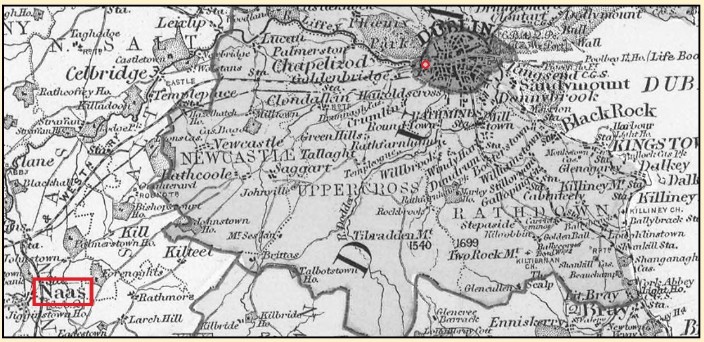
Barracks and Town
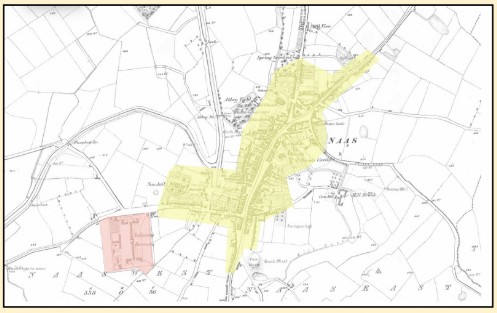
6-Inch Map, Ordnance Survey of Ireland
Site of Naas Barracks Today
Download from Major Tweedy's Neighborhood
All these documents are in .pdf files. To download the file, click on the document link. The document will open in a new browser window.
Newspaper article in a pdf file, RDF_Leaving.pdf (11 kb).
On April 30, 1904, King Edward VII arrived in Naas to attend the races at the nearby Punchestown Racecourse. Newspaper article in a pdf file, RoyalVisitPunchestown.pdf (145 kb).
Newspaper article in a pdf file, RDF_DepotInspection_2.pdf (195 kb). The article is dated June 18, 1904, a Saturday, and refers to Thursday's inspection.
Pages and Documents on Other Websites
The above link is to an article by Paddy Behan, a local historian. It appears on the website NaasTown.com, a commercial site that promotes tourism and local businesses. The article's page will open in a new browser window.
Click on the icon on the right for the website of the Naas Local History Group. It will appear in a new browser window.
History of horse racing at Punchestown by C. Costello and R. Smith, History Ireland (Summer 2000). The article's webpage will open in a new browser window.
Click on the icon on the right for the website of the History Ireland. It will appear in a new browser window.
Barracks Plans - The Military Archives, Irish Defence Forces
Click on the links below to view the plans. Click on the icon to the right for the home page of the Military Archives which will open in a new browser window. Ownership of both the digital images and the underlying documents is claimed by the Republic of Ireland. Accordingly, non-personal use of the material in any form requires the permission of the state through the Officer-in-Charge, Military Archives. Additionally, if such permission is obtained, proper attribution must be given to the utilized material.
Documents open in the Archives' digital viewer in a small, pop-up window. To view the high resolution image right-click on the image in the pop-up window then select " Open Link in a New Window ." After the new, full-size window opens left-click on the image. Note that the first time you try to access a high resolution the Archive's website will require you to agree to the terms use. Click on the "I agree to the terms of use" link, close the window, then click on the low resolution image again. You will have access to the plans for the remainder of your session on the Military Archives' website.
Military Archives MPD/AD119289-007Military Archives MPD/AD119288-009Military Archives MPD/AD119292-001Military Archives MPD/AD119289-010Military Archives MPD/AD119290-009
Photographs - National Library of Ireland
These links will take you to digitized photo pages on the website of the National Library of Ireland. The photographs are by John French taken between 1865 and 1917. These digitized images are property of the NLI. See the library's terms of use if you wish to use any of these files in a website, print publication, or ebook.
Click on the icon to the right for the home page of the National Library of Ireland which will open in a new browser window. Click on the links below to view the photographs which will open in a pop-up window.
Looking north.Lawrence Collection, LCAB 08211
The trainees are in dark parade uniforms or light-colored fatigue uniforms. The training cadre are in service khaki. Note the drummer/buglers on the right holding bugles. On the far right, with a Sam Browne belt, is an officer, most likely the depot commander. To his left, holding a notebook is the Company Sgt-Major. Note also the children enjoying the show.
Looking south.Lawrence Collection, LROY 07836
The woman with the pram is most likely the wife of one of the training cadre.
Looking north.Lawrence Collection, LROY 07837
The men on horses could be off-duty officers. Officers rarely were in uniform off-post.
Lawrence Collection, LROY 07841Lawrence Collection, LROY 07842Lawrence Collection, LROY 07826
A moat, or "mote," was an artificial hillock on which stood a wooden fort. They were built by both the Irish and Norse prior to the tenth century. For more on the Naas Moat, click here for a 1999 article by Paddy Behan. The page, which will open in a popup window, is from the website of the County Kildare Community Network.
Lawrence Collection, LROY 07838Lawrence Collection, LROY 07845Eason Collection, EAS 2609
This is the Grand Canal that extends to Dublin and empties into the Liffey at Irishtown. Note the man on the canal wall who was reading a book and is now watching the photographer.
[ You are at www.majortweedy.com>Royal Dublin Fusiliers>Naas Barracks ]
